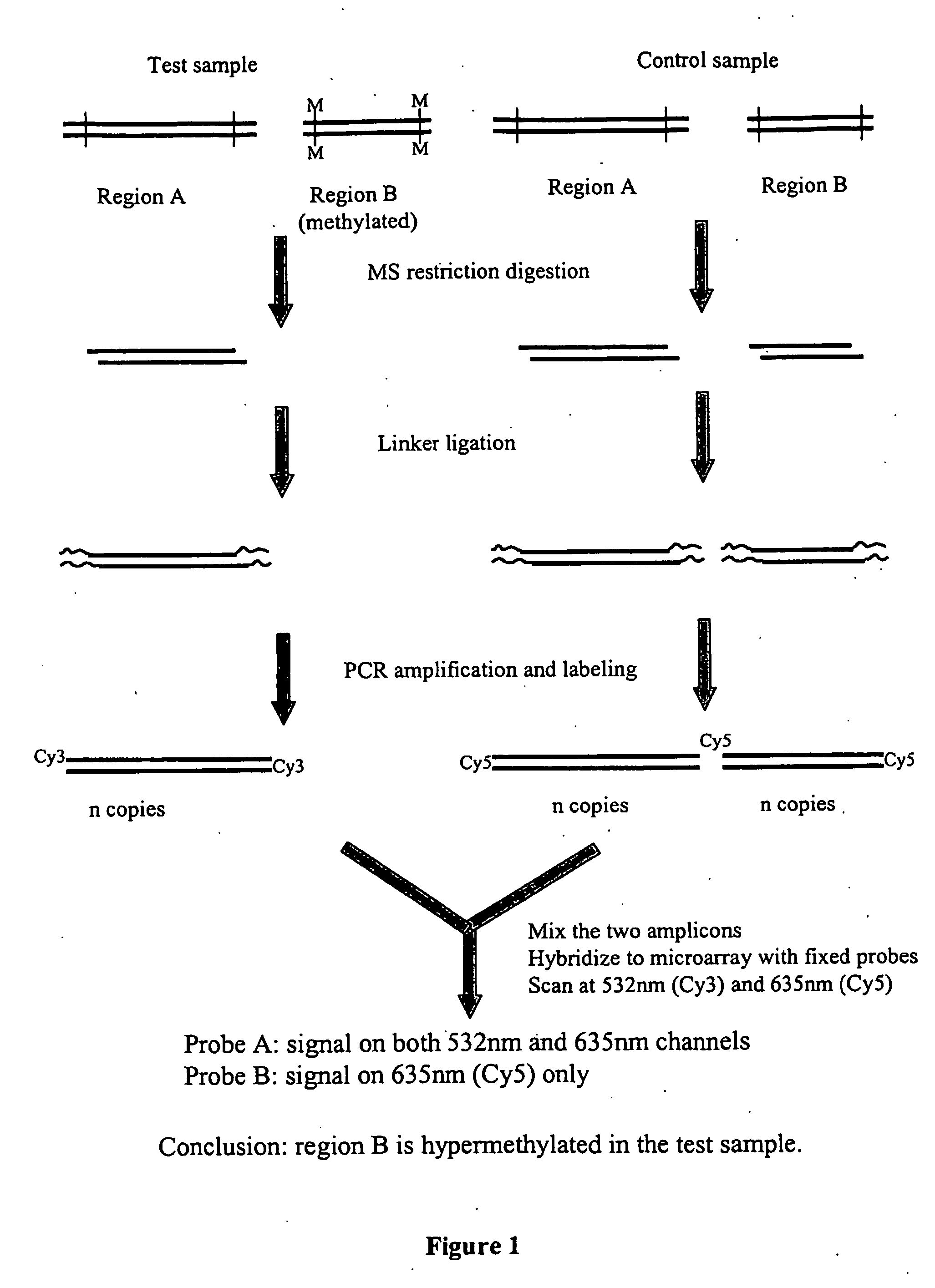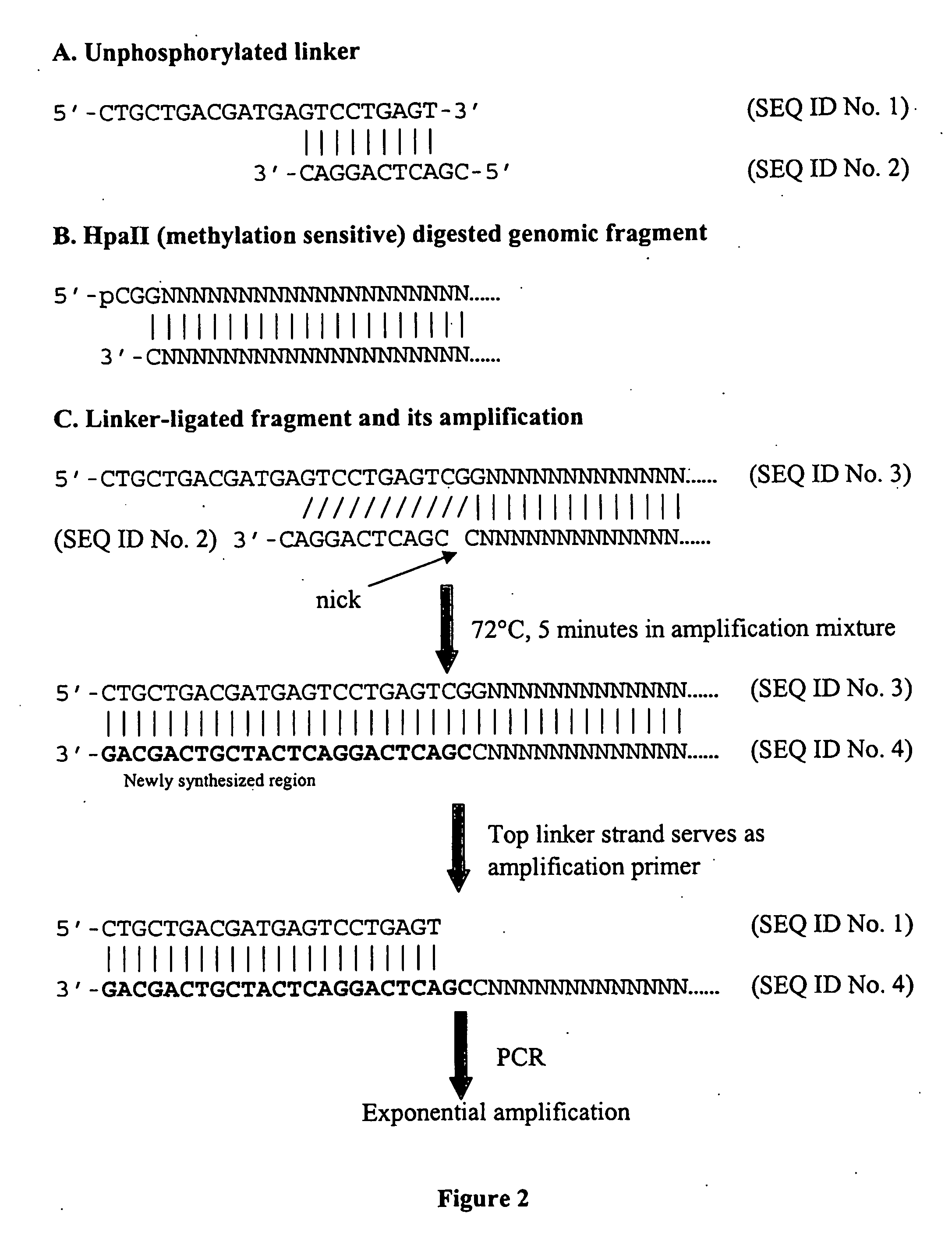Assays for dna methylation changes
a nucleotide sequence and methylation technology, applied in the field of dna methylation changes assays, can solve the problems of difficult pcr amplification, and difficult to detect changes in methylation patterns
- Summary
- Abstract
- Description
- Claims
- Application Information
AI Technical Summary
Benefits of technology
Problems solved by technology
Method used
Image
Examples
example 1
Direct Microarray Screening of Differentially Methylated Sites (“DMS2) for a Mouse Transgene
[0089] This example demonstrates the use of an embodiment of the present invention for detecting the extent of methylation of a transgene in mouse DNA. The method involves a DNA amplification step and is referred to as DMS2 (direct microarray-based screening of differentially methylated sites).
[0090] Oligonucleotides of 50-60 nucleotides in length were synthesized for hybridizing to selected CpG islands in mouse genes and for hybridizing to a mouse transgene known as HRD (Engler et al., (1991) Cell 65(6):939-47). HRD provides a useful control DNA in the assay because the transgene is highly methylated in one mouse strain (C57BL / 6J, abbreviated as B) and unmethylated in another (DBA / 2J, abbreviated as D), and HRD is integrated in the mouse genome in amounts comparable with other mouse genes. FIG. 5A is a Southern blot that demonstrates that the transgene is methylated in strain B but not in ...
example 2
Screening of Differentially Methylated Sites Using a cDNA Microarray
[0097] This example demonstrates the use of an embodiment of the present invention for detecting the extent of methylation of mouse genes using a high-density cDNA microarray. The mixture of Cy-3 and Cy-5 labeled DNA amplicons were prepared as described in Example 1 and hybridized to the M9K mouse cDNA microarray, which contains approximately 9000 sequence-verified cDNA clones spotted on a microscope slide. The hybridized array was scanned at 532nm and 635 nm as described in Example 1.
[0098] An overlay of the two scans was achieved by pseudo-coloring (green for Cy-3 and red for Cy-5). Four independent hybridizations were performed and the results indicate a high degree of reproducibility. Most of the spots show a yellow color of weak intensity, indicating that the genomic regions for the clones are not differentially methylated (they have similar methylation level) and likely are unmethylated in both samples. Red ...
example 3
Screening of Differentially Methylated Sites in Human Breast Cancers Using a 762-Feature CpG Island Fragment Microarray
[0099] In this example, 2 μg of genomic DNA from three human breast tumor cell lines, T47D, MB435, and SKBR3, were digested with HpaII overnight at 37° C. One fourth of the digested DNA was ligated to 10 μl of 100 μM of the unphosphorylated linker shown in FIG. 2 in 30 μl reaction at 16° C. for 5-16 hours. A 0.2 ml PCR tube contained the following mixture: 10 μl of the ligation product, 10 μl of 10× reaction buffer, 10 μl of 2 mM dNTPs, 20 μl of 5M betaine (Sigma-Aldrich, St Louis, Mo.), 5 μl DMSO, 44.5 μl H2O, and 0.5 μl (2.5 units) of Taq polymerase (Applied Biosystems, Foster City, Calif.). PCR conditions were as follows: 72° C., 5 minutes, then 94° C., 3 minutes followed by 25 cycles of 94° C., 30 seconds; 60° C., 30 seconds; 72° C., 3 minutes. The amplified samples were stored at 4° C. Amplified products (amplicons) were purified with Qiagen PCR purification k...
PUM
| Property | Measurement | Unit |
|---|---|---|
| excitation wavelength | aaaaa | aaaaa |
| excitation wavelength | aaaaa | aaaaa |
| diameter | aaaaa | aaaaa |
Abstract
Description
Claims
Application Information
 Login to View More
Login to View More - R&D
- Intellectual Property
- Life Sciences
- Materials
- Tech Scout
- Unparalleled Data Quality
- Higher Quality Content
- 60% Fewer Hallucinations
Browse by: Latest US Patents, China's latest patents, Technical Efficacy Thesaurus, Application Domain, Technology Topic, Popular Technical Reports.
© 2025 PatSnap. All rights reserved.Legal|Privacy policy|Modern Slavery Act Transparency Statement|Sitemap|About US| Contact US: help@patsnap.com



